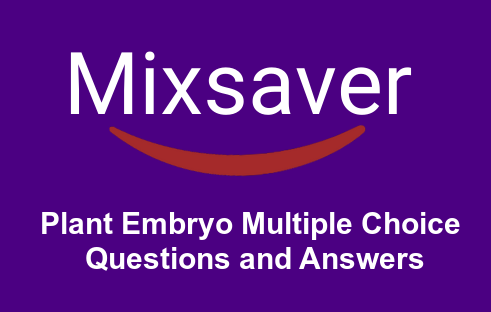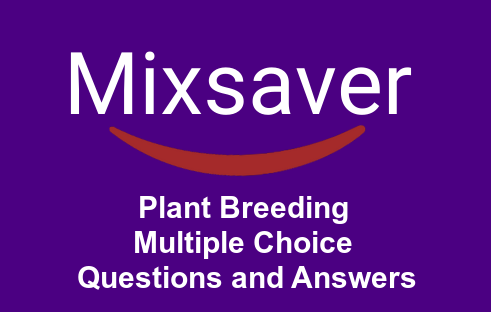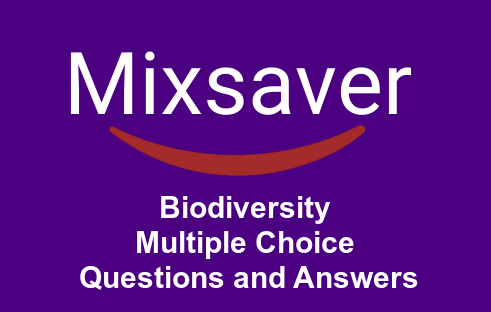Embryology question bank pdf | Embryology important questions
1. What is meant by double fertilisation ?
( a ) Fusion between egg and male gamete
( b ) Fusion between secondary nucleus and male gamete
( c ) Both ( a ) and ( b )
( d ) Formation of two zygotes
Ans. c
2. Of the two cells of zygote , the cell near to micropyle is termed as
( a ) terminal cell
( b ) basal cell
( c ) embryo cell
( d ) zygote cell
Ans. b
3. When pollen tube enters through the funiculus or integument it is called
( a ) porogamy
( b ) chalazogamy
( c ) mesogamy
( d ) isogamy
Ans. c
4. In the post – fertilisation changes within the ovule , the oospore forms the ……. , while the fertilised fusion nucleus ( product of triple fusion ) develops the …….. respectively .
( a ) endosperm , embryo
( b ) embryo , endosperm
( c ) nucellus , embryo
( d ) embryo , nucellus
Ans. b
5. In which of the following plants , pollen tube enters through integuments ?
( a ) Casuarina
( b ) Malva neglecta
( c ) Cucurbita
( d ) Beta vulgaris
Ans. c
6. Double fertilisation occurs in
( a ) Pinus
( b ) Selaginella
( c ) Funaria
( d ) Dalbergia
Ans. d
7. Which of the following forms the embryo ?
( a ) Egg apparatus
( b ) Antipodal cell
( c ) Fertilised ovum
( d ) Fertilised synergid
Ans. c
8. A mature dicot embryo has
( a ) one cotyledon
( b ) two cotyledons
( c ) three cotyledons
( d ) four cotyledons
Ans. b
9. Pollen tube enters through chalazal tissue is called chalazogamy and is found in
( a ) Cucurbita
( b ) Pistacia
( c ) Casuarina
( d ) None of these
Ans. c
10. Fertilisation of the egg takes place inside the
( a ) anther
( b ) stigma
( c ) pollen tube
( d ) embryo sac
Ans. d
Langman embryology mcqs pdf | Medical embryology practice questions pdf
11. Which of the following cells secrete enzymes to dissolve ?
( a ) Synergid cell
( b ) Egg cell
( c ) Central cell
( d ) Both ( a ) and ( b )
Ans. a
12. In porogamy , the pollen tube enters into the ovule via
( a ) chalaza
( b ) micropyle
( c ) integuments
( d ) None to these
Ans. b
13. Ovule converts into which of the following after fertilisation ?
( a ) Fruit
( b ) Embryo
( c ) Seed
( d ) Both ( a ) and ( c )
Ans. c
14. Fruit is formed after fertilisation by which of this following part ?
( a ) Ovule
( b ) Ovary
( c ) Calyx
( d ) Synergids
Ans. b
15. Zygote divides first into basal cell and terminal cell which of these cell is present towards chalazal pole ?
( a ) Basal cell
( b ) Terminal cell
( c ) Antipodal cell
( d ) Suspensor cell
Ans. b
16. The portion of the embryonal axis was above the level of cotyledons forms
( a ) hypocotyl
( b ) epicotyl
( c ) Both ( a ) and ( b )
( d ) None of these
Ans. b
Embryology questions medical school pdf | General embryology mcq pdf
17. Cotyledons in embryo is formed from
( a ) basal cell
( b ) terminal cell
( c ) Both ( a ) and ( b )
( d ) None of these
Ans. b
18. Calyx after fertilisation
( a ) develop into fruit
( b ) develop into seed
( c ) develop into ovary
( d ) fall off
Ans. d
19. The portion below the epicotyl is
( a ) suspensor
( b ) cotyledons
( c ) hypocotyl
( d ) None of these
Ans. c
20. In Beta vulgaris , the pollen tube reaches the embryo sac via
( a ) micropyle
( b ) integuments
( c ) chalaza
( d ) None of these
Ans. c
21. Longest pollen tube occurs in
( a ) Cucurbita
( b ) Dahlia
( c ) grass
( d ) maize
Ans. d
22. What is the another name of vegetative fertilisation ?
( a ) Triple fusion
( b ) Double fertilisation
( c ) Somatogamy
( d ) Syngamy
Ans. a
23. In a flowering plant , the pollen tube first arrives in
( a ) an antipodal cell
( b ) a synergid
( c ) a central cell
( d ) egg
Ans. b
24. Which out of these mechanism does not lead to the formation of clones ?
( a ) Vegetative reproduction
( b ) Apomixis
( c ) Double fertilisaion
( d ) Tissue culture
Ans. c
25. What does the phenomenon called if the pollen tube enters the embryo sac through base of a funiculus or the integument ?
( a ) Mesogamy
( b ) Isogamy
( c ) Porogamy
( d ) Chalazogamy
Ans. a
26. Agamospermy is
( a ) diplospory
( b ) apospory
( c ) adventitious embryony
( d ) All of these
Ans. d
27. Formation of an embryo from egg of an embryo sac developed directly from a cell nucellus is
( a ) diplospory
( b ) apospory
( c ) adventitious embryony
( d ) None of these
Ans. b
28. Structure whose outgrowth helps in fertilisation is
( a ) stigma
( b ) placenta or funiculus
( c ) pollen tube
( d ) pollen grains
Ans. b
29. Chalazogamy is found in
( a ) Pisum
( b ) Pistacia
( c ) Casuarina
( d ) Cucurbita
Ans. c
30. Embryo from an unfertilised egg is
( a ) allogamy
( b ) apogamy
( c ) parthenocarpy
( d ) parthenogenesis
Ans. d
31. Double fertilisation in angiosperm was first explained by
( a ) N. Borlaug
( b ) Nawaschin
( c ) Maheshwari
( d ) Stewart
Ans. b
32. Apomixis is the type of reproduction that result in the development of
( a ) embryo from nucellus
( b ) embryo from endosperm
( c ) new organism without fusion of gametes
( d ) None of the above
Ans. c
33. A plant has 25 chromosomes in ‘ microspore mother cell ‘ . The number of chromosomes in its endosperm will be
( a ) 36
( b ) 24
( c ) 48
( d ) 12
Ans. a
34. Process in which fertilisation occurs without fusion of gametes
( a ) amphimixis
( b ) parthenogenesis
( c ) apomixis
( d ) autogamy
Ans. c
35. During the process of fertilisation , when one nucleus fuses with egg and the second with the secondary nucleus , it is called
( a ) double fertilisation
( b ) triple fusion
( c ) single fertilisation
( d ) triple fertilisation
Ans. a





